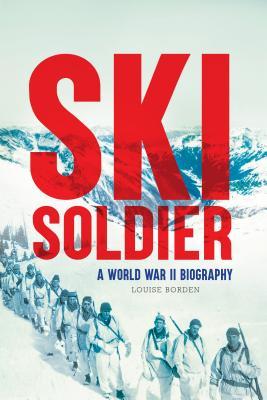 Borden, Louise. Ski Soldier
Borden, Louise. Ski SoldierSeptember 11th 2018 by Calkins Creek Books
Copy provided by the publisher
Growing up in the 1930s near Boston, skiing was possible, but not the huge, slick sport it is now. It had a vast appeal for young Peter Seibert, who had an old pair of skis, permission from a neighbor to use the only available slight rise in the area, and a love of being outdoors in the winter. When his father took a job in New Hampshire, Peter finally got the opportunity for more mountainous skiing, and made good friends in high school who also skied. He was only 17 when WWII started, and he soon heard about Minnie Dole, a skier who was recruiting men to form a ski patrol unit. Peter eventually joined, and spent WWII in a variety of locations with the 10th Mountain Soldiers, becoming injured at one point. Upon returning after to the US, he started skiing again, although his injuries gave him some challenges. He worked up to being able to race again, and made the US Olympic team in 1950. In the late 1950s, with his friend Earl Eaton, he headed to Colorado to start a ski resort, and opened Vail Ski Resort in 1962. It was hard work, but something that he loved, and he kept skiing until his death in 2002.
Strengths: I love when I can connect nonfiction with fiction books, and this is a great companion to Preuss' Shadow on the Mountain and Duble's Phantoms in the Snow. Skiiing is not a huge pastime in Central Ohio, but I do have a few students interested in it, and its use in WWII is certainly not well covered. For some reason, my 6th graders are enormously interested in this topic in history, which surprised me. Clearly, still room for more new books on this 80 year old military conflict. (Spanish American War books, anyone?)
Weaknesses: While many middle grade readers will appreciate the huge amount of white space on the page, I am never a fan of prose cut up into shorter lines. The format does allow for lots and lots of photographs, though, which is very informative.
What I really think: Definitely glad to add to my collection, especially this year. Can't say I've ever had a 6th grader who has already read more of my literary nonfiction books, like No Better Friend.
Martin, Iain. In Harm's Way: In Harm's Way: JFK, World War II, and the Heroic Rescue of PT 109
July 31st 2018 by Scholastic Press
Copy provided by Young Adult Books Central
While many young readers have heard of President John F. Kennedy, few know about anything other than his assassination. While this book concentrates on the events surrounding Kennedy's war time service and the aftermath of the enemy attack on the PT boat he was commanding, it gives a nice overview of Kennedy's family and life both before and after this, and discusses the ramifications of Kennedy's military service and injuries on his political career.
Illustrated with annotated period photographs that add personality and perspective to the narrative, this book helpfully fills in information that young readers will not already have. The "Kennedy Family Scrapbook" insets are especially enlightening, discussing (in a positive way) the family dynamics, lifestyle, and expectations. The Pacific Theater is not as well covered as the European Theater, so maps, photographs of the scenery, and discussions of key players and events are helpful in placing the use of the PT boats.
The real draw is, of course, the harrowing adventure of the PT boat being hit by enemy fire and cut in half. Kennedy and some of the crew survived the initial attack, but the real test was being stranded in the water and then struggling to an island, hoping all the time to elude the notice of the Japanese. Grit, determination, and a lot of sheer luck contributed to the survival of Kennedy and several of his men, but the horrific conditions caused several others to perish before being rescued. Kennedy's return and an overview of the rest of his life round out the book nicely.
Readers who enjoy a good survival story like Olson's Lost in the Pacific, 1942: Not a Drop to Drink, Spradlin's Into the Killing Seas, or those with an interest in Kennedy or biographies of other World War II luminaries will appreciate this updated and sanitized look at a pivotal occurrence in the life of one of the 20th century's most admired men.
My students will love this, and I'm glad to have it, but I've read accounts of JFK's presidential years and can't quite get over the fact that he had female companionship provided by gangsters. Frequently. He wasn't quite the nice man this book portrays him to be, but he at least had an upbringing that taught him to make it LOOK like he was a nice man in the thoughts, words, and deeds that were visible to the American people. Public figures today might learn from this subterfuge!
























No comments:
Post a Comment